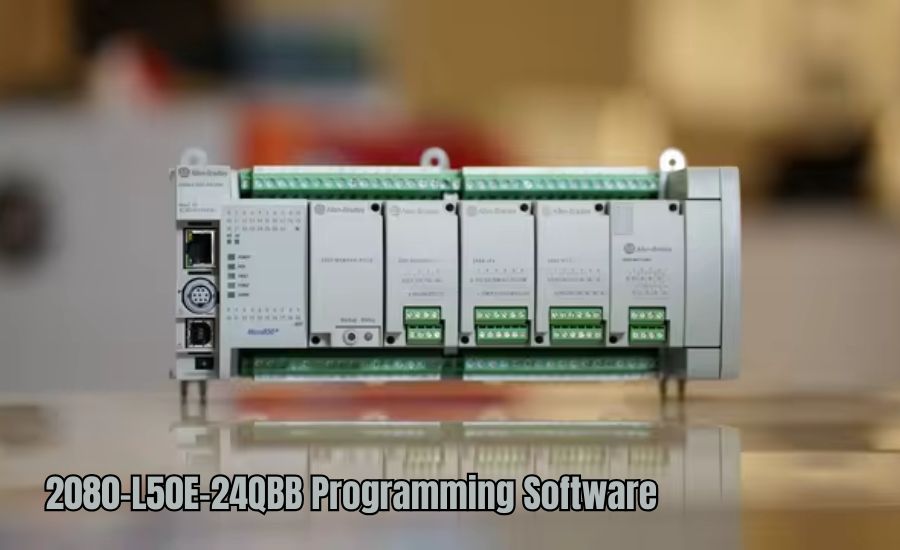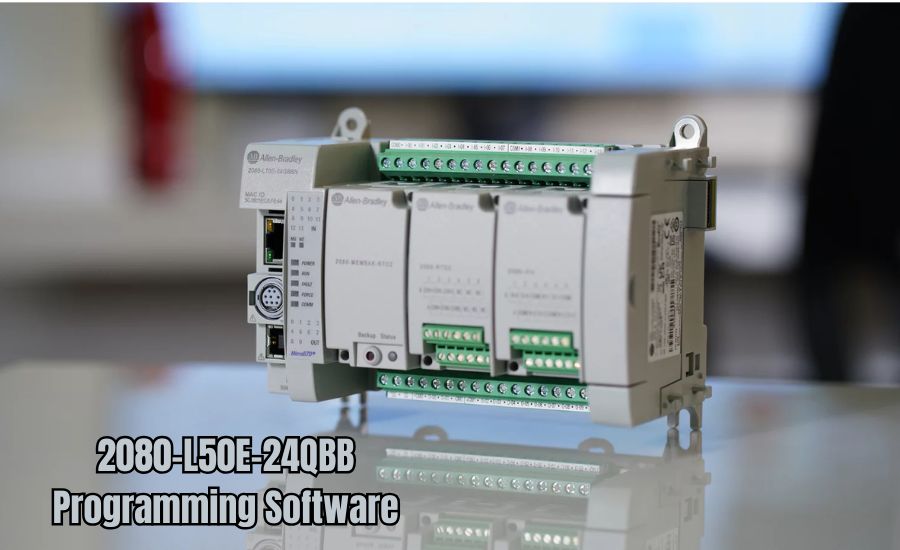2080-L50E-24QBB Programming Software: Unlocking the Future of Automation

Automation is pivotal in enhancing efficiency, reliability, and overall productivity in today’s industrial landscape. The 2080-L50E-24QBB programming software is at the forefront of this revolution, offering innovative solutions for programmable logic controllers (PLCs) used in various applications. This article provides a comprehensive overview of the 2080-L50E-24QBB programming software, including its features, installation process, programming techniques, troubleshooting tips, practical applications, and future trends.
Overview of 2080-L50E-24QBB Programming Software
The 2080-L50E-24QBB is part of the Allen-Bradley Micro850 series of PLCs, designed to cater to the growing demands of industrial automation. These controllers are known for their reliability and versatility, making them suitable for various tasks. The programming software associated with this controller, known as Connected Components Workbench (CCW), offers a user-friendly interface and powerful features that facilitate efficient programming and control.
Key Features of 2080-L50E-24QBB
The 2080-L50E-24QBB programming software is equipped with numerous features that enhance its functionality:
- Input/Output Capabilities:
- The controller supports up to 14 24 VDC/VAC inputs and 10 source outputs, allowing for various applications in different industrial settings.
- This extensive I/O capability makes it suitable for controlling various devices and systems, from sensors to actuators.
- Communication Ports:
- It includes embedded USB programming and Ethernet ports, enabling seamless connectivity for easy setup and management.
- The Ethernet port allows integration with networked devices, facilitating communication across multiple systems.
- High-Speed Counters:
- The controller supports up to 4 high-speed counter channels, enabling precise control in applications that require quick response times.
- This feature is handy in manufacturing processes where speed and accuracy are critical.
- Expansion Options:
- Users can expand their system with Point I/O, supporting up to 132 I/O points through additional modules.
- This scalability ensures that the 2080-L50E-24QBB can grow alongside your operational needs.
These key features position the 2080-L50E-24QBB programming software as a powerful tool for modern industrial applications.
Benefits of Using 2080-L50E-24QBB Programming Software

The 2080-L50E-24QBB programming software offers several advantages that make it a preferred option among automation professionals:
- User-Friendly Interface: The software Connected Components Workbench (CCW) is designed to be intuitive, allowing users to develop and test their programs quickly.
- Robust Performance: It provides reliable operation even in demanding environments, ensuring your systems run smoothly.
- Scalability: The ability to expand I/O points means that the software can grow with your business needs.
- Integration with Modern Technologies: The 2080-L50E-24QBB is designed for seamless integration with IoT devices, enabling more imaginative automation solutions.
These benefits ensure that users can maximize their productivity and efficiency.
Getting Started with the 2080-L50E-24QBB Programming Software
Starting with the 2080-L50E-24QBB programming software involves a straightforward setup process. This section will guide you through the installation and configuration steps.
Installation of Connected Components Workbench (CCW)
To utilize the 2080-L50E-24QBB, you must install the Connected Components Workbench (CCW) software. Here’s how to do it effectively:
- Download the Software:
- Visit the Rockwell Automation website or authorized distributors to download the latest version of CCW. It’s essential to ensure you have the most recent version to access all features and updates.
- Check System Requirements:
- Ensure that your PC meets the hardware and software specifications for optimal performance. Typically, CCW requires a Windows operating system, adequate RAM, and sufficient storage space.
- Installation Steps:
- Run the installer and follow the on-screen instructions. This process usually includes agreeing to the terms and conditions, selecting the installation directory, and choosing components to install.
- After installation, activate the software using a valid serial number provided during purchase. This step is crucial for accessing all CCW features.
Following these steps, the CCW software will be installed and ready for use.
Creating Your First Project
Once you have the CCW installed, you can create your first project. This process involves several simple steps:
- Open CCW:
- Launch the CCW software on your computer to begin the project creation process.
- New Project Setup:
- Navigate to the “Project” menu and select “New.” This action will prompt you to choose the appropriate controller model, which, in this case, is the 2080-L50E-24QBB.
- Name your project and configure initial settings, such as communication protocols and other parameters relevant to your application. This initial setup is crucial as it lays the foundation for your programming efforts.
- Add Devices:
- After creating your project, you can add devices and configure them. This step may involve specifying input and output devices, setting up communication options, and defining device properties.
Completing these steps will prepare you to begin programming your controller effectively.
Configuring Communication Settings
Setting up communication between your PC and the 2080-L50E-24QBB is essential for seamless operation. Here’s how to configure these settings:
- Connect Hardware:
- Use a USB cable for the initial setup or an Ethernet cable for direct connection. For Ethernet configurations, ensure that your PC is connected to the same network as the controller.
- Configure IP Address:
- Access the Ethernet settings in CCW to assign a static IP address compatible with your network. For example, you can set it to 192.168.0.90. This step ensures that your PC can communicate effectively with the controller.
- Test Connectivity:
- Use the command prompt to ping the controller’s IP address. This action confirms successful communication and helps identify potential issues before starting programming.
Ensuring proper communication settings sets the stage for the successful programming and operation of your 2080-L50E-24QBB.
Programming Basics: Ladder Logic Programming
Ladder Logic is the primary programming language used within CCW for the 2080-L50E-24QBB. This section will guide you through the basics of creating Ladder Logic programs.
Creating Ladder Logic Rungs
Creating Ladder Logic rungs involves the following steps:
- Insert Rungs: Drag and drop elements from the instruction toolbox into your ladder diagram to create rungs.
- Define Conditions: Use contacts and coils to set conditions for input/output operations. This is where you determine how the controller should respond to various inputs.
- Simulate Logic: Utilize the simulation features within CCW to test your logic before deploying it to the controller. This helps identify and resolve any issues in your program.
These steps make it easier to create effective control programs.
Advanced Programming Techniques
As you become more familiar with the 2080-L50E-24QBB programming software, explore advanced programming techniques, such as implicit messaging.
- Implicit Messaging: This feature allows efficient data exchange between devices over Ethernet/IP.
- Configure Messaging Instructions: Use built-in instructions in CCW to set up messaging between controllers or devices.
- Monitor Messages: Utilize monitoring tools in CCW to track message status and troubleshoot communication issues.
Mastering these techniques can enhance your programming skills and improve system performance.
Troubleshooting Common Issues

Even the most advanced software can encounter issues. Here are some common problems associated with the 2080-L50E-24QBB programming software and how to resolve them.
Connection Problems
If you encounter connection issues between your PC and the controller, consider the following troubleshooting steps:
- Check Cables:
- Inspect both the USB and Ethernet cables, as a loose connection can cause communication problems.
- IP Configuration:
- Verify that the IP address settings on your PC and the controller match. Mismatched addresses will prevent successful communication. To enhance connectivity, use the same subnet mask for both devices.
- Firewall Settings:
- Ensure that your firewall is configured to allow CCW access to the network. Sometimes, firewalls can block communication, leading to connection failures.
Programming Errors
Errors in your programming logic can lead to unexpected behavior in your automation systems. Here’s how to troubleshoot common programming issues:
- Use the Simulator:
- Use the simulation feature in CCW regularly to test your logic. This step helps you identify logical errors before they impact your systems.
- Review Error Codes:
- If your program does not execute as expected, review the error codes generated by the controller. These codes provide valuable insight into what went wrong, guiding you toward potential fixes.
- Consult Documentation:
- For guidance on resolving specific errors, refer to the CCW user manual or online resources. These resources often provide troubleshooting tips and detailed explanations of error codes.
Performance Issues
If you notice performance degradation in your system, consider these strategies to improve efficiency:
- Optimize Code:
- Review your Ladder Logic for inefficiencies. Streamline your code by eliminating unnecessary rungs or combining similar operations. Optimized code improves execution speed and reduces the load on the controller.
- Monitor System Load:
- Use CCW’s monitoring tools to track CPU and memory usage. High usage may indicate the need for code optimization or the addition of hardware resources.
- Regular Maintenance:
- Schedule regular maintenance checks to ensure all components of your automation system are functioning correctly. Keeping hardware in good condition prevents performance issues over time.
By addressing these common issues proactively, you can maintain the reliability and efficiency of your 2080-L50E-24QBB programming software and connected systems.
The 2080-L50E-24QBB programming software is utilized in various industries, showcasing its versatility and effectiveness. Here are some practical applications.
Industrial Automation Projects
- Manufacturing Processes: The 2080-L50E-24QBB is commonly used to automate assembly lines. Its real-time monitoring capabilities ensure that production processes run smoothly and efficiently.
- Water Treatment Facilities: In these facilities, the software helps control pumps and valves based on sensor inputs, maintaining water quality and system integrity.
- Building Automation Systems also playficantly manages HVAC systems efficiently, contributing to energy savings and comfort in commercial buildings.
Case Studies of Success
- Manufacturing Efficiency Improvement: A case study highlighted how a manufacturing plant used the 2080-L50E-24QBB to streamline its assembly line, resulting in a 20% increase in productivity through improved control of machine operations.
- Smart Building Management: Another application involved integrating multiple 2080-L50E controllers in a smart building setup. This allowed centralized control over lighting, HVAC, and security systems via Ethernet/IP communication, enhancing operational efficiency and reducing energy costs.
These applications illustrate the significant impact of the 2080-L50E-24QBB programming software in real-world settings.
May You Like This: Airmoto Reviews
Future Trends in Automation with 2080-L50E-24QBB
The future of automation is evolving rapidly, and the 2080-L50E-24QBB programming software is poised to play a significant role in this transformation.
Integration with Artificial Intelligence (AI)
The integration of AI into automation systems is a game changer. The 2080-L50E-24QBB programming software can leverage AI algorithms to enhance decision-making processes, predictive maintenance, and anomaly detection. This evolution enables systems to learn from historical data, making operations more innovative and efficient.
Increased IoT Connectivity
As IoT devices become more prevalent in industrial settings, the 2080-L50E-24QBB is expected to support even more extensive connectivity options. Enhanced IoT capabilities will allow real-time data exchange, enabling more imaginative automation solutions that respond dynamically to changing conditions.
Focus on Cybersecurity
The 2080-L50E-24QBB programming software will likely incorporate advanced security features to protect against cyber threats. This focus will ensure the integrity of automation systems and safeguard sensitive data.
Advanced Analytics
Incorporating advanced analytics tools within the 2080-L50E-24QBB programming software will enable users to extract valuable insights from operational data. This capability will facilitate data-driven decision-making, helping organizations optimize processes and improve performance.
Conclusion
The 2080-L50E-24QBB programming software is a cornerstone of modern automation solutions. Its powerful features, user-friendly interface, and versatility make it an ideal choice for various applications. As industries continue embracing automation, the 2080-L50E-24QBB will be pivotal in driving efficiency and productivity.
By mastering this software, users can unlock new possibilities for their operations, adapting to the ever-evolving landscape of industrial automation. Whether you are a seasoned professional or just starting in the field, the 2080-L50E-24QBB programming software equips you with the tools necessary for success in a dynamic industry.
FAQs
Q: What is the 2080-L50E-24QBB?
A: The 2080-L50E-24QBB is a programmable logic controller (PLC) part of the Allen-Bradley Micro850 series, designed for industrial automation applications.
Q: How do I install the CCW software?
A: Download the software from the Rockwell Automation website, run the installer, and follow the on-screen instructions to complete the installation.
Q: Can the 2080-L50E-24QBB connect to IoT devices?
A: It is designed for seamless integration with IoT devices, enabling more imaginative automation solutions.
Q: What programming language is used with the 2080-L50E-24QBB?
A: The primary programming language is Ladder Logic, supported by the Connected Components Workbench (CCW) software.
Q: How can I troubleshoot connection issues?
A: Verify cable connections, check IP configurations, and ensure that firewall settings allow CCW access to the network.
Follow us for the latest recipe news and updates: USA MAGENE







